Preguntas Frecuentes
Bienvenido a la sección de preguntas y respuestas frecuentes de CO4Kids. Aquí puede encontrar respuestas a preguntas sobre signos de abuso y descuido infantil, cómo convertirse en padre de acogida y adopción.

Enlaces Rápidos:
Bienvenido a la sección de preguntas y respuestas frecuentes de CO4Kids. Aquí puede encontrar respuestas a preguntas sobre signos de abuso y descuido infantil, cómo convertirse en padre de acogida y adopción.

Enlaces Rápidos: